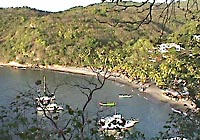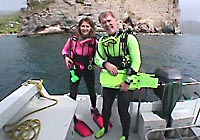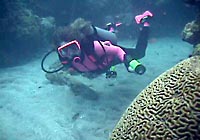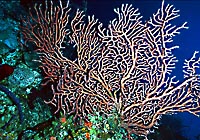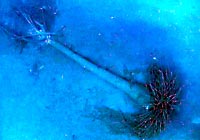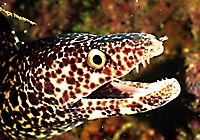 |
|||||||||||||||||||||||||
Last November, a big hurricane (Lenny) passed through the Caribbean. Lenny didn't hit St. Lucia, but it caused huge waves to slam into the normally calm west coast of this island. Waves 25 feet high swept away palm trees and pushed rocks onto the beach. As we prepare for today's dive, we wonder if Lenny caused much damage to the coral reefs. (Since our underwater scooters are still stuck in Customs, we're using our fin power.) To make our survey easier we grab our gear and underwater cameras and hop on a boat that will drop us off at the end of the point so we can swim back. We jump, feet first, into the water with a big splash. Our dive starts at a site called "Fairyland" and goes through "Anse Chastanet Reef" and ends back at the beach. Fairyland got its name because it seemed like a magical place. Rocks, corals and sponges here make interesting and colorful shapes underwater. The water is warm, clear and blue. As we slowly sink toward the bottom, 30 feet underwater, we see a colorful variety of rocks and corals below us. Recent storms have caused some damage to the large, colorful sea fans, tube sponges and corals. Fortunately the reef will eventually heal itself. This fall when the corals spawn, new corals will settle and grow to replace the damaged areas. After a severe storm the coral reef may become a more diverse ecosystem than it was before the storm. A greater variety of corals may support a greater variety of other marine life. (This is similar to how fires can be beneficial to forests by removing some of the tall, larger trees so smaller plants and trees can grow.) We swim around, over and through the maze of rocks and corals until we come to the drop-off, also called a "wall." The wall starts at 30 feet underwater and drops down to 200 feet. We swim out over and along the wall. (Imagine a bird flying over the edge of the Grand Canyon.) At 60 feet underwater we see deepwater gorgonian sea fans, undamaged by the storms. The deeper you go underwater the less you can feel the waves overhead. We see a large school of fish swimming above us. As we get closer to the beach, the bottom starts to rise up toward the shallow water. Peering down into the deep water, at the bottom of the sand slope, we saw something! Can you guess what we saw? We decided, instead, to make our first scuba dive today. Just as we were getting ready for our dive, Scuba St. Lucia manager Karyn Allard ran up to us and said she heard a 40-foot-long whale shark had been spotted between the Pitons! (The whale shark is the biggest fish in the world, growing to 60 feet long! It is also one of the most harmless sharks.) We were excited as the prospect of seeing a whale shark because, although we've made thousands of dives all around the world, we have never seen one. As we're watching the moray, my dive computer beeps. My computer is signaling me that I am getting low on air. I signal Karen that it is time to get out of the water, so we leave the moray behind as we swim to the beach. As we get out of the water we are sure glad that we don't have 25-foot waves pounding into the beach today! We're also glad we didn't find as much damage to the reef as we had expected. We would like to come back in the future to see how the reef has grown and changed after Hurricane Lenny. Tomorrow we explore other more remote coral reefs around St. Lucia by kayak. |
Our expedition base is on the left end of the beach at Anse Chastanet.
We are ready to make our dive at Anse Chastanet point.
Karen swims along the shallow reef looking at some brain coral.
This large deep water gorgonian coral we found was growing on the side of the wall at 60 feet underwater. It is about 4 feet high.
Guess what this is at the bottom of the sea, more than 90 feet underwater.
A spotted moray eel. This moray eel is about 2 1/2 feet long. During the day moray eels hide in the coral reefs, then come out at night to catch sleeping fish. |
||||||||||||||||||||||||
home | basecamp | archives | other expeditions | kids' page | contact us © 2001, The Ocean Adventure All rights reserved. |
